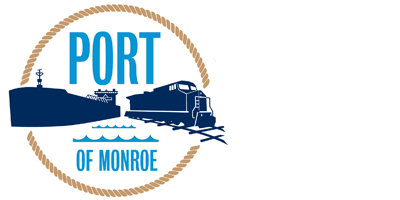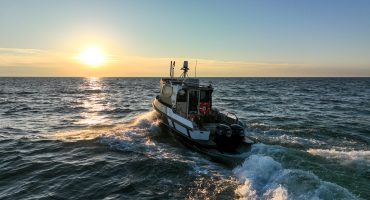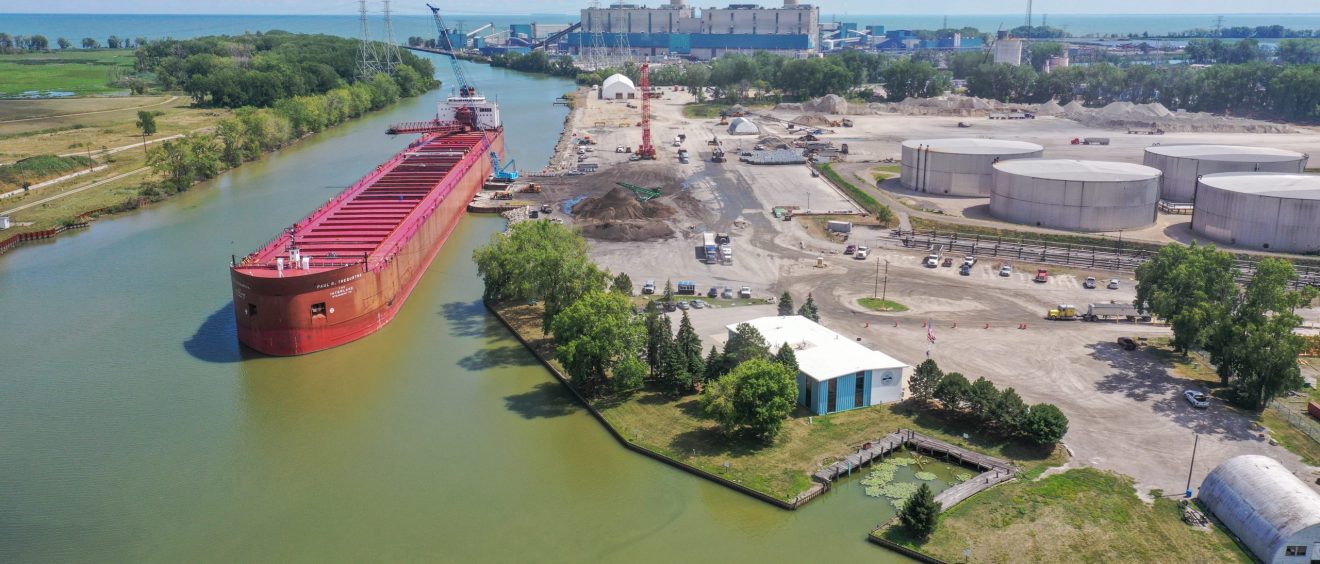
Engineering the Port of Monroe
The Port of Monroe, located on the shores of Lake Erie, is undergoing a massive transition. The port is the beneficiary of funding from the federal, state, and local level to increase efficiencies and bring the port into the next generation of Great Lakes shipping.
Background on the port
The Port of Monroe has long been considered a port with massive potential due to its location between Detroit and Toledo and proximity to major markets. In 1927, a group of Monroe citizen formed a group called the industrial commission, which later became the Monroe Port Commission. The commission established the Port of Monroe in 1932.
A $390,000 appropriation from Congress funded harbor improvements that would help the new port capitalize on its maritime potential. A terminal was constructed on the east side of the River Rasin, which included a dock face, warehouse, two building-mounted gantry cranes, and rail spur.
The Monroe Harbor Terminal was completed in 1940, but the port continued to be defined by its potential rather than its activity. While the Port functioned as an import hub for Renault automobiles and a layup destination for United States Steel steamers in the 1960s, commerce into Monroe declined.
The construction of the DTE Monroe Power Plant at the mouth of the River Raisin in the 1970s generated a massive increase in maritime tonnage for the Monroe harbor, but the Port’s facilities further up the River Raisin struggled to generate consistent cargo. Eventually all staff positions were eliminated, including port director, as the Monroe Port Commission could not justify the jobs given the lack of activity.
Everything changed in 2012, when the port commission hired Paul C. LaMarre III from the Toledo-Lucas County Port Authority to reinvigorate maritime operations in Monroe. Under LaMarre’s leadership, the Port of Monroe has rebuilt its image through strategic partnerships and niche cargo operations.
Rebirth and re “berth”
The initial focus for LaMarre was to analyze current supply chains in Monroe and determine if the Port could improve upon or create new transportation solutions. This effort found that synthetic gypsum produced at the DTE Monroe Power Plant was being trucked to a landfill. Through a partnership with DTE and DRM Terminal Management, this same product is being exported from the Port to beneficial reuse markets around the Great Lakes region. This early success story is how Monroe got back on the map.
In order to capitalize on new cargo opportunities, the Port required significant infrastructure upgrades. All that remained of the original terminal complex along the turning basin was the seawall. In 2017, the Port constructed a wharf alongside the River Raisin. The goal of this construction was to build a new cargo handling berth at the Port’s point of deepest draft. The project was financed through the Michigan Economic Development Corporation’s tax increment financing program.
Current cargoes
Today, the Port handles a number of different commodities. The DTE Monroe Power Plant continues to be the primary tonnage driver in the Monroe harbor, importing loads of coal and limestone and producing the synthetic gypsum and bottom ash byproducts that are exported from the Port’s facilities.
The port receives a large amount of coiled steel products by rail and vessel that are ultimately trucked to regional automotive manufacturers.
Monroe is the only port in the United States to have a wind tower manufacturer located within its complex. Ventower Industries has used the port to ship completed wind towers to domestic and international destinations.
Michigan Paving & Materials operates a large liquid asphalt blending facility at the Port. Michigan Paving is served by a pipeline from the turning basin dock.
The future
An important focus for any port is to identify new cargo opportunities and pursue new business. Great Lakes shipping is in a time of immense change.
Major steelmakers are moving away from basic oxygen furnaces in favor of electric arc furnaces to produce steel, and utilities like DTE Energy are moving away from coal fired power plants in favor of renewable energy sources.
These changes will create a ripple effect in the types of raw materials demanded, materials that have historically been transported by Great Lakes freighters. This has created an increased focus on diversification for ports and maritime transportation companies alike.
These opportunities cannot be fully realized without the proper infrastructure. In the last two years the Port of Monroe has attracted funding from federal, state, and local sources to build out new infrastructure that will strengthen the future of the port, diversify its cargo base, and support its network of partners.
Port Infrastructure Development Program
In October 2022, the Port of Monroe was awarded a Port Infrastructure Development Program grant for its Lake Erie Renewable Energy Resilience project. Funding for this project was secured by Senator Gary Peters and supported by Michigan Governor Gretchen Whitmer, in addition to many other regional and local stakeholders. This grant will help the port rehabilitate its existing facilities and build out new operating areas for future cargo operations.
New riverfront berth
The primary focus of Monroe’s PIDP grant is to reconfigure the port’s operating areas to increase the exports of renewable energy components manufactured at the Port by Ventower Industries. Ventower is the only wind tower manufacturer located at a port in the United States, and their towers have been exported to domestic and international markets.
The Port will construct a second berth on the River Raisin, identical to the existing one, that is dedicated for the handling of wind energy components. The addition of a new asset to be exclusively used in support of Ventower’s operations will increase the Monroe manufacturer’s competitiveness and allow the Port to concentrate its cargo operations in different areas.
The construction of offshore wind farms on the East Coast of the United States are a massive opportunity for Ventower. The tower sections demanded for offshore projects are much larger than the onshore sections that have been moved from Monroe, and the new dock will be capable of handling these larger components.
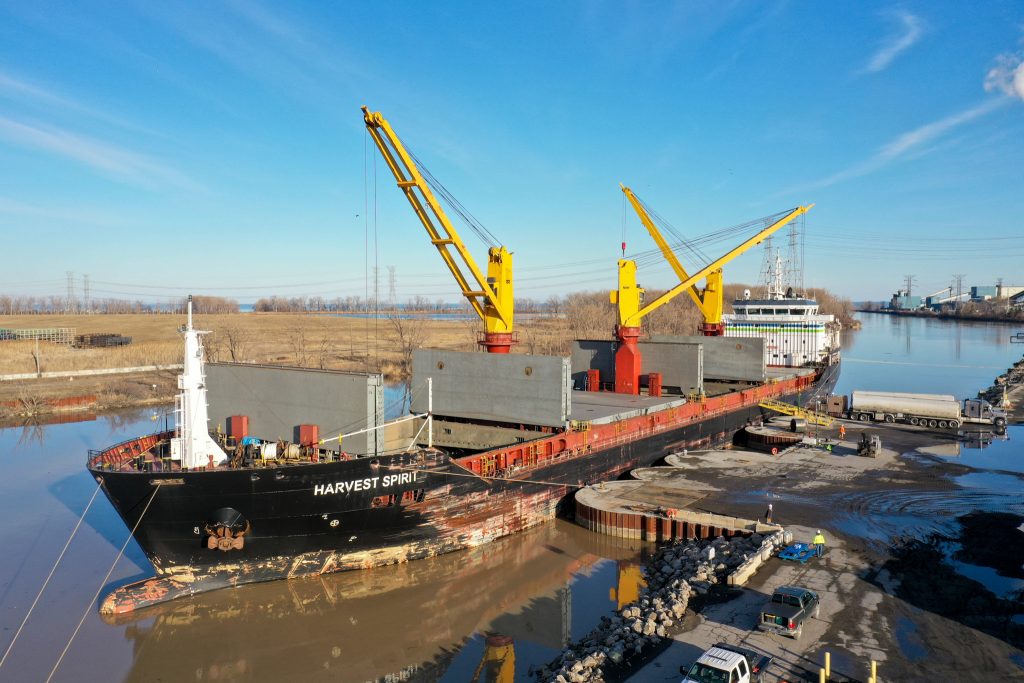
The Harvest Spirit at the Port’s existing riverfront wharf.
Turning basin dock rehabilitation
What remains of the original terminal along the turning basin continues to be a valuable part of current operations in Monroe. The Port plans to rehabilitate the entire concrete cap of the turning basin dock for future operations. There are three segments to this area; a section of steel sheet pile cells with a concrete face and cap; a section of steel sheet pile cells with a concrete face; and a section of a straight face steel sheet pile wall. The entire concrete cap and concrete face has greatly deteriorated after years of use and will be fully rehabilitated. Also involved in the planned work in this area is the replacement of the straight face steel sheet pile wall located immediately adjacent to the turning basin dock. Failure of the tie-back system in this section exacerbated by many storms and water level changes common on the tumultuous Lake Erie has resulted in the sheet pile wall collapsing in to the water.
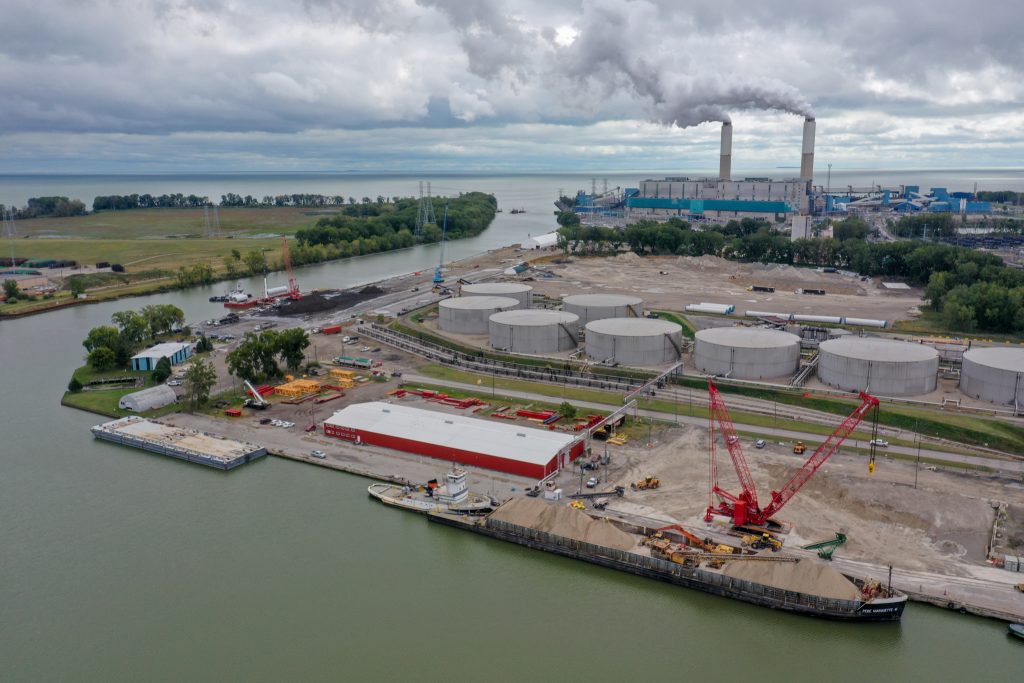
The Port’s Turning Basin dock – originally built in the 1930s
Maritime Readiness Slip
In the 1970s, a small slip for personal watercraft was excavated next to the Port of Monroe’s current office building. This slip has deteriorated in condition to the point where further erosion limits its functional use and poses a significant safety and structural risk to the Port of Monroe office building. As a solution, and with the assistance of the PIDP funding, the Port is planning to completely rehabilitate this slip and make it a new operating area at the port. Once rehabilitated, the new “Maritime Readiness Slip” will accommodate fast rescue boats from the local fire and police department, small government vessels, and the Port’s harbor tug. By focusing on this slip, the new construction will sustain the ground near the port office and move smaller vessels to a dedicated area where they do not interfere with commercial vessel operations. This location next to the port office also makes it easier for groups to mobilize in the event of an emergency.
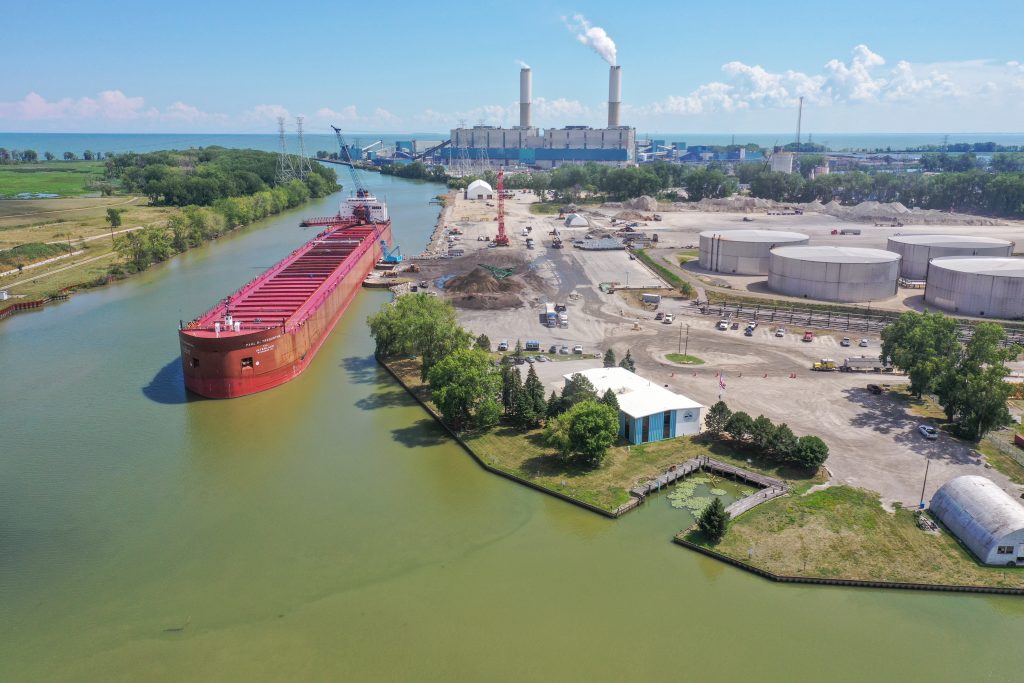
A view of the small boat slip that will be rehabilitated and its proximity to the Port’s main office.
Shore power
Another consideration given to the Port’s PIDP grant was shore power. The Port is currently working with its maritime stakeholders to understand the shore power needs of the different vessels that frequent the Port. The Port will determine a solution with its engineers to allow vessels to connect to shore power at both riverfront wharves as well as the new maritime readiness slip.
PIDP conclusion
Great Lakes ports have been unable to consistently improve and innovate their operations due to lack of available funds, and as a result have been slow to innovate. Vessels have traditionally been the change agents in the Great Lakes maritime industry with the development of self-unloading technology and the continuous improvement of these systems. Not only does the PIDP provide ports a dedicated source of funding to improve and expand operations, but it also allows authorities the opportunity to innovate and develop new solutions for the betterment of the entire maritime industry.
Container terminal – the Michigan Maritime Gateway
Great Lakes ports must consider containerized cargo opportunities in the future as demand for traditional cargoes fluctuate. The Port of Monroe has explored the opportunities associated with container handling for many years and will utilize funds from the City of Monroe, State of Michigan, Federal Emergency Management Agency, and United States Customs and Border Protection to install modern container inspection equipment at a preexisting building at the Port. The result will be the Michigan Maritime Gateway, the first maritime container terminal in the State of Michigan. The MMG will be the first terminal in the United States that will scan 100% of containers and breakbulk with by USCBP non-intrusive technology.
The container terminal is being developed and marketed as a new cargo handling capability for the Port, not as a large-volume container terminal and storage yard. The Port plans to build a niche container service in partnership with Spliethoff of Amsterdam that complements existing terminals on the Great Lakes in Cleveland, Ohio and Duluth, Minnesota. A network of container ports in the Midwest will expand opportunities for domestic short-sea-shipping routes within the Great Lakes. The Port will utilize a Manitowoc crawler crane, purchased with funds from the USDOT Marine Highway Program, to handle containers.
Not only will the Michigan Maritime Gateway provide Monroe County importers and exporters access to new markets, it will create a new supply chain link for the electric vehicle, semiconductor, and renewable energy investments that have been made in Michigan.
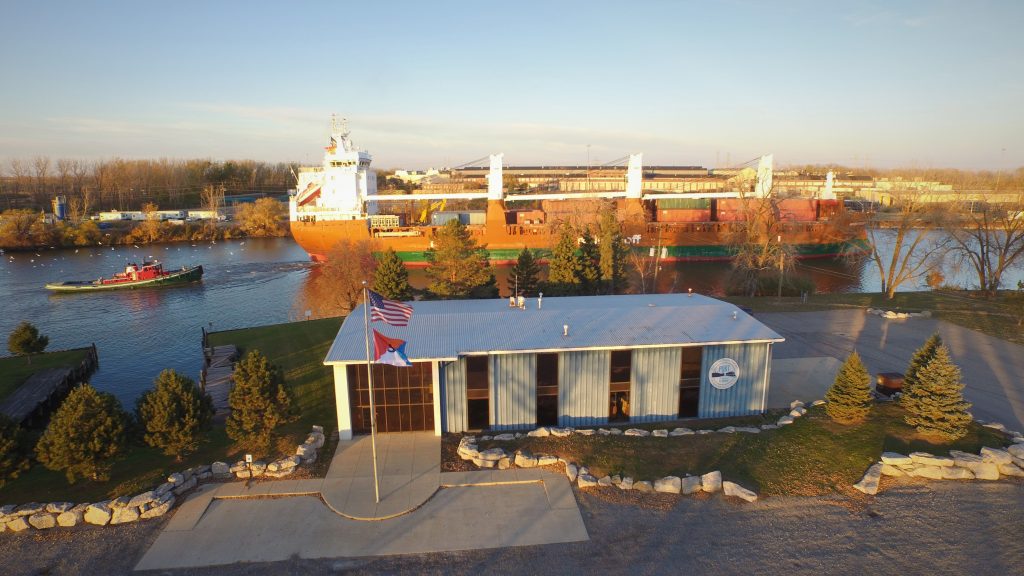
The Port of Monroe’s future will include container shipping.
Conclusion
The Port of Monroe is supported in its ongoing projects by the Monroe Port Commission. Engineering services are provided by the exceptional team at DLZ Corporation’s Waterford Office and Torrey Enterprises provides critical grant support.
Future infrastructure projects at the Port of Monroe will be complemented by the Maritime and Port Facility Assistance Office within the Michigan Department of Transportation. The new office will administer grants that will support and sustain Michigan’s maritime infrastructure. A key function of this state-level assistance program will be serving as the local match for federal grant programs like the Port Infrastructure Development Program. This will allow Michigan, the state with the most ports on the Great Lakes, to secure more federal funds for its diverse network of port facilities.
With over $30 million in grant funding secured from federal, state, and local sources, the Port of Monroe is finally capitalizing on its potential.
This article was written by Port Development Coordinator Samuel C. Hankinson for the January 2024 edition of (mt) magazine published by the Society of Naval Architects & Marine Engineers (SNAME)
